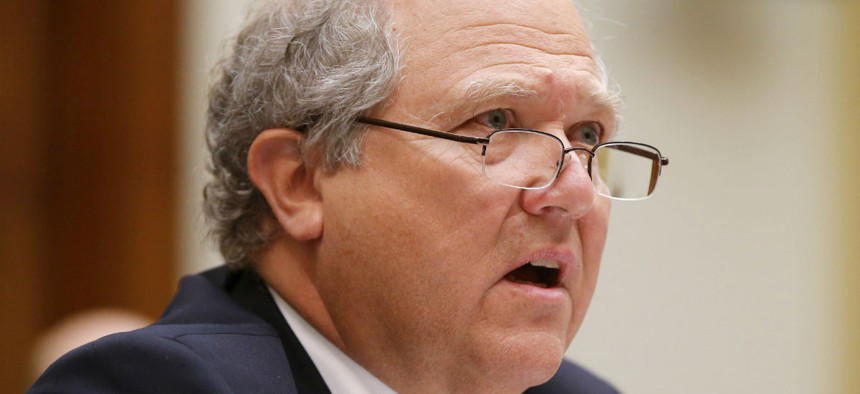
John Sopko, Special Inspector General for Afghanistan Reconstruction, says widespread corruption doomed many projects. AP file photo
U.S. Policies in Afghanistan Abetted Corruption on a Massive Scale
Watchdog cites a multi-agency failure to prioritize the threat early on.
Fifteen years after the U.S. invasion of Afghanistan, it is clear that a multi-agency failure to focus on the threat of corruption is a major reason for the instability that persists in that war-torn country, a watchdog said on Wednesday.
John Sopko, Special Inspector General for Afghanistan Reconstruction, said U.S. “policies and practices unintentionally aided and abetted corruption” as he released a report titled “Corruption in Conflict: Lessons from the U.S. Experience in Afghanistan.”
“Corruption directly threatens the viability and legitimacy of the Afghan state,” he told an audience at the Carnegie Endowment for International Peace. It “alienates key elements of the population, discredits the government and security forces, undermines international support, subverts state functions and rule of law, robs the state of revenue, and creates barriers to economic growth.”
Sopko characterized corruption as “massive bribes, everyday extortion, thefts of fuel and equipment, ghost soldiers and civil servants, padding of payrolls, contract fraud, shoddy construction, and other misdeeds” that his office has been documenting in audits since his appointment in 2012.
The report does not spare U.S. agencies from responsibility for the corruption’s spread as $115 billion in U.S. aid dollars flowed into the country. “Our report discusses evidence that for many years, Defense, State, and USAID did not place a high priority on anticorruption. This flowed in part from an early, high-level aversion to ‘nation-building,’ which was not conducive to long-term investments in accountability,” he said in his speech.
“But the lack of attention to corruption also flowed from the overwhelming focus on security, political stability, and rebuilding. These goals largely took precedence over building good governance and the rule of law.”
U.S. agencies contributed by injecting tens of billions of dollars into the Afghan economy, using flawed oversight and contracting practices, and partnering with malign powerbrokers, the report said. And the corruption allowed U.S. money to flow to the insurgency as many Afghans turned to the Taliban as a way of expressing opposition to the government, which in turn eroded public confidence.
The report cites poor U.S. oversight, procurement, and contracting practices that enabled corrupt behavior.
“For our part, the bureaucratic temptation to use money as evidence of commitment, and the urge to spend down accounts for fear of losing funds in the next round of appropriations, added to the rush of the reconstruction funding stream,” Sopko said.
“U.S. political commitment also wavered. Given our security and political goals, U.S. officials had to make hard judgment calls on how much political capital to invest in anticorruption efforts.” American agencies failed to fully employ more aggressive tools, like visa revocation, strict conditionality on aid, or prosecution of corrupt officials with dual U.S. citizenship,” the IG said.
On the plus side, the report documents how resources were added and the Pentagon and USAID “improved their oversight and vetting of contractors. Those improvements, however, coincided with drawing down our presence, and some effective units were down-sized or closed—possibly prematurely,” Sopko said.
While bribery and exploitation in Afghanistan goes back centuries, “after 2001, internal drivers of corruption—including insecurity, weak systems of accountability, and the drug trade—combined with new drivers: a huge influx of foreign assistance, poor oversight of that assistance, and a willingness to partner with abusive and corrupt powerbrokers,” the report says.
But more than just understanding what went wrong, Sopko stressed, the U.S. must learn lessons for the long term. “If you expect that the United States will continue to be drawn into overseas contingency operations—whether in a conflict setting like Afghanistan or in a non-combat contingency like our response to Haiti’s devastating 2010 earthquake—we need to know what we can do to improve execution and outcomes in the future in the face of the corruption threat.”
Former ambassador Ryan Crocker and regional commander Gen. John Allen encouraged the IG in 2014 to report on lessons learned, Sopko said. His IG office is “unique” in that it can take a “whole of government” critique of Afghanistan policy rather than being confined to a single agency.
It assembled a team of subject-matter experts, conducted more than 80 interviews, obtained unpublished documents and vetted drafts with all relevant agencies, including the State, Defense, Treasury and Justice departments, he said.
The report makes 11 recommendations, three for Congress and eight for the executive branch. “It is not meant as a critique or criticism of the many brave men and women who worked in Afghanistan over the last fifteen years,” Sopko said. “The United States cannot wage the Afghan government’s anticorruption campaign for it.”
Asked whether the report might raise some hackles at agencies as some of his audits have, Sopko said, “We got a lot of buy-in from State, DoD, Treasury and Justice. It’s different from normal reports because of the consensus.” But he acknowledged that some may object if they feel like it “impinges on some program, or costs more money” or calls for too much interagency cooperation. “We had to lay out the history, but we’re not accusing the generals—we’re telling the story.”
Sopko was introduced with praise by Sarah Chayes, senior associate in the Democracy and Rule of Law Program at the Carnegie Endowment, who drew a sharp contrast between Sopko’s aggressive style and that of his predecessors.
Wednesday’s report will be the first in a series from SIGAR’s Lessons Learned Program. Later in September, Sopko said, his office will release a report in conjunction with the U.S. Institute of Peace sharing insights from the international community's experiences in Afghanistan reconstruction.







